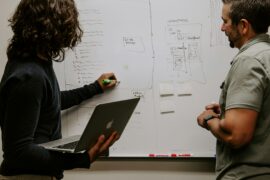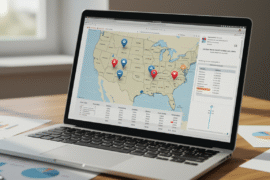This article may contain references to products or services from one or more of our advertisers or partners. We may receive compensation when you click on links to those products or services. Nonetheless, our opinions are our own.
The information presented in this article is accurate to the best of our knowledge at the time of publication. However, information is subject to change, and no guarantees are made about the continued accuracy or completeness of this content after its publication date.
For many entrepreneurs, leasing space or equipment is a smart move. It keeps overhead manageable, preserves cash, and offers flexibility. But when it comes to accounting for those leases? That’s where things can get complicated—fast.
Whether you’re leasing an office, a vehicle, or machinery, understanding how to manage lease accounting under the latest standards is crucial. Mistakes here don’t just affect your books—they can impact your funding, tax reporting, and strategic planning. This guide breaks it down in a way that’s useful, not overwhelming.
Why Lease Accounting Matters to Your Business
Leases aren’t just contracts—they’re financial obligations. And the way you record them has a direct effect on your balance sheet and income statement. For startups and growing businesses, that visibility is key.
Misclassifying a lease can:
- Overstate or understate your liabilities
- Skew your cash flow projections
- Make you look riskier (or healthier) to potential investors
- Lead to compliance issues during audits
In short, lease accounting is more than bookkeeping—it’s a financial clarity tool.
What Changed With Lease Accounting?
If you’re still treating operating leases as off-the-books expenses, you’re operating under outdated rules. The Financial Accounting Standards Board (FASB) issued ASC 842, a new lease accounting standard, to fix that.
Under ASC 842, businesses must now recognize most leases on their balance sheet. That means both finance leases (formerly capital leases) and operating leases now show up as right-of-use (ROU) assets and lease liabilities.
The goal? Greater transparency for lenders, investors, and regulators. And while that’s a good thing, it also means more accounting work for entrepreneurs.
Learn more about the core requirements of asc 842, including what qualifies as a lease, how to calculate lease liabilities, and how to transition from legacy accounting rules.
Types of Leases and How to Treat Them
Understanding lease classification is step one. ASC 842 splits leases into two types:
Finance Leases (formerly Capital Leases)
These are long-term, ownership-like leases. They usually involve:
- A transfer of ownership at the end of the term
- A bargain purchase option
- A lease term covering most of the asset’s useful life
- Present value of lease payments ≈ fair market value
Accounting treatment:
- ROU asset and lease liability on the balance sheet
- Interest expense and amortization separately recorded on the income statement
Operating Leases
These are traditional leases with no transfer of ownership. Think office space or short-term equipment rentals.
Accounting treatment:
- Also require ROU asset and lease liability on the balance sheet
- Single lease expense recognized on a straight-line basis over the lease term
Even though the income statement treatment is simpler, the balance sheet implications are now just as significant as finance leases.
Voted "Best Overall Budgeting App" by Forbes and WSJ
Monarch Money helps you budget, track spending, set goals, and plan your financial future—all in one app.
Get 50% OFF your first year with code MONARCHVIP
What Entrepreneurs Need to Track
Lease accounting under ASC 842 isn’t a “set it and forget it” process. You’ll need to actively manage and track multiple pieces of information. Here’s a checklist to help:
- Lease start and end dates
- Payment schedules (including variable components)
- Discount rates for calculating present value
- Renewal options and termination clauses
- Lease incentives and initial direct costs
- Modifications or measurements
Using a spreadsheet might be okay for a single lease—but if you have more than two or three, it’s worth considering lease accounting software to automate calculations and reporting.
Practical Tips to Stay Compliant
Navigating lease accounting doesn’t have to be stressful. Here are a few practical strategies to simplify the process:
- Start early: Don’t wait until year-end to gather lease data. Set up a tracking system from the start.
- Consult professionals: A good CPA can help classify leases correctly and ensure ASC 842 compliance.
- Centralize documentation: Store all lease contracts, amendments, and correspondence in one place.
- Reassess annually: Lease terms, payment structures, or usage may change—make sure your accounting reflects that.
- Use tools: Lease accounting platforms can automate amortization schedules, journal entries, and financial reporting.
These habits help reduce errors and build confidence in your numbers—especially if you’re preparing for investor due diligence or an audit.
Real-World Impact of ASC 842
The switch to ASC 842 wasn’t just a paperwork shuffle—it had real consequences for businesses. Public companies already transitioned in 2019, and private companies had until 2022–2023.
So what happened? Many firms saw a significant increase in their reported liabilities. According to Deloitte, the average balance sheet impact was a 15%–20% increase in liabilities for companies adopting ASC 842.
For small businesses and startups, this visibility can affect:
- Loan eligibility – Lenders often scrutinize lease liabilities
- Valuation – Investors analyze your debt and asset mix
- Financial ratios – Metrics like debt-to-equity or EBITDA may shift
Understanding these shifts early gives entrepreneurs an edge—because if you can explain your financials with confidence, you’re ahead of the game.
Final Thoughts
Lease accounting may not be the flashiest part of entrepreneurship, but it’s one of the most important. Especially in today’s compliance-focused world, knowing how to track, report, and strategize around leases can improve your bottom line and build investor trust.
Take time to understand the basics of ASC 842. Classify your leases correctly. Keep your records clean. And when things get too complex, don’t hesitate to lean on experts or technology to make it manageable.
Because at the end of the day, smart financial management isn’t just about making money—it’s about knowing exactly where it goes, how it’s committed, and what that means for your future.

Reviewed and edited by Albert Fang.
See a typo or want to suggest an edit/revision to the content? Use the contact us form to provide feedback.
At FangWallet, we value editorial integrity and open collaboration in curating quality content for readers to enjoy. Much appreciated for the assist.
Did you like our article and find it insightful? We encourage sharing the article link with family and friends to benefit as well - better yet, sharing on social media. Thank you for the support! 🍉
Article Title: The Ultimate Guide to Lease Accounting for Entrepreneurs
https://fangwallet.com/2025/04/02/the-ultimate-guide-to-lease-accounting-for-entrepreneurs/The FangWallet Promise
FangWallet is an editorially independent resource - founded on breaking down challenging financial concepts for anyone to understand since 2014. While we adhere to editorial integrity, note that this post may contain references to products from our partners.
The FangWallet promise is always to have your best interest in mind and be transparent and honest about the financial picture.
Become an Insider

Subscribe to get a free daily budget planner printable to help get your money on track!
Make passive money the right way. No spam.
Editorial Disclaimer: The editorial content on this page is not provided by any of the companies mentioned. The opinions expressed here are the author's alone.
The content of this website is for informational purposes only and does not represent investment advice, or an offer or solicitation to buy or sell any security, investment, or product. Investors are encouraged to do their own due diligence, and, if necessary, consult professional advising before making any investment decisions. Investing involves a high degree of risk, and financial losses may occur including the potential loss of principal.
Source Citation References:
+ Inspo
There are no additional citations or references to note for this article at this time.












































